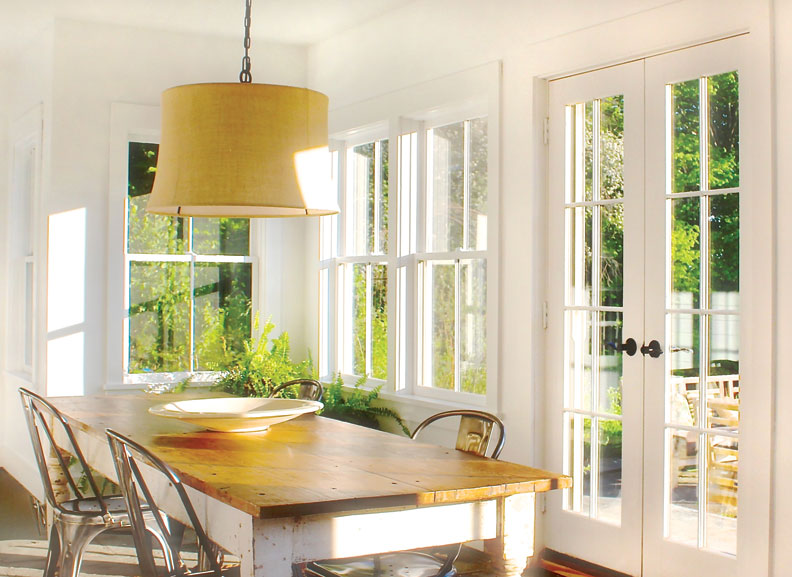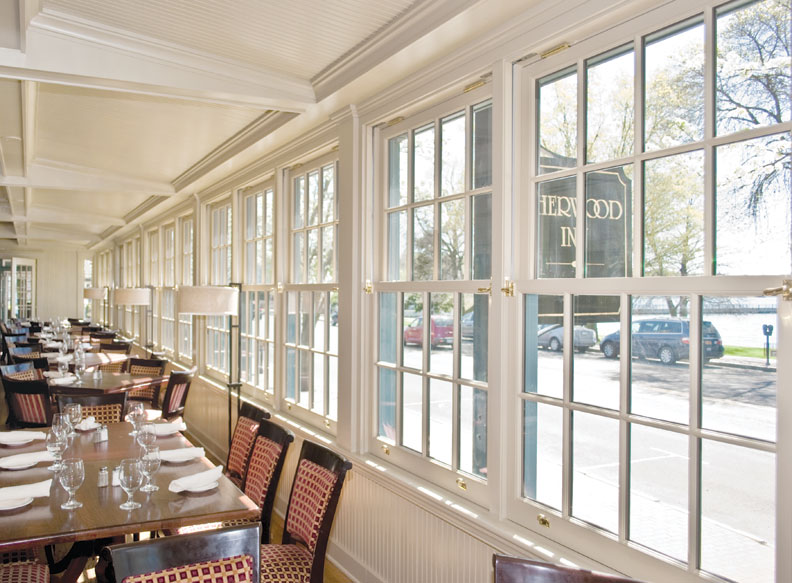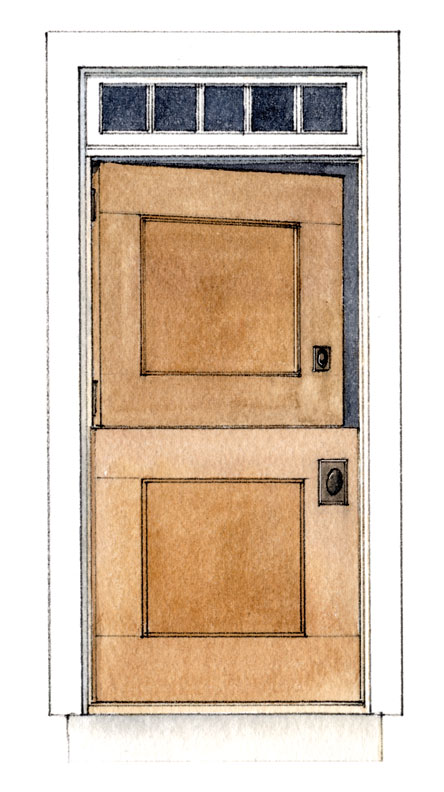
Green Mountain Windows designs perfectly proportioned windows.
Windows and doors are portals of light, of air, of human activity. On a practical level, they allow ingress and egress. They keep out the unwanted—excess heat and cold, insects and other small creatures, and rain. More than that, though, doors symbolize our hospitality, and windows frame our views. Together, they are the face that meets the street. Whether restoring, renovating, or shopping for new old windows and doors, you will face both opportunities and challenges as you stand on the threshold of faithfulness to the past and judicious use of present technologies.
In times past, available materials and elemental realities often dictated architectural style. Andy Keefe of Green Mountain Window explains the historic trajectory: “Farmhouses in areas settled early in American history typically have small pane sizes since imported glass was generally only available in 6″ x 8″ or 7″ x 9″. These early farmhouses often had 12-over-12 double-hung windows.” Once the country started making its own glass, he continues, “the light sizes became larger, and by the mid-19th century, the two-over-two pattern with one vertical muntin dividing the glass became the quintessential farmhouse style.”
Today, new materials and construction techniques afford environmental benefits as well as improved means for emulating past craftsmanship. Twenty-first-century glass, for example, not only keeps heat either in or out and modifies the sun’s rays, but it also can deaden outside noise, an important benefit for those historic homes built on main byways.

Heartwood Windows and Doors’ foldup window is perfect for a porch or kitchen.
Though you may want to maintain the original glass in the windows of a beloved farmhouse, colonial Saltbox, Gothic cottage, or Arts & Crafts bungalow, the reality of heat loss or air escape may take precedence. With renovation or creation, you have the opportunity to use energy-efficient krypton or argon gas-infused panes. You also may decide to add a bit of UV coating to regulate sun exposure. In these situations, the key is moderate use of new technologies.
Sandra Vitzthum, a Vermont-based architect, loves that new glass can be made to look imperfectly old and embraces double-paned windows for better insulation, but she stops short of recommending available triple pane lights, as their thermal efficiency rarely exceeds their expense. As for UV coating, which helps regulate both heating and cooling, she says, “I usually specify 72 percent; more coating can make the glass seem more blue on the inside.”
While using these new technologies makes sense for renovation and new construction projects, in the case of some restorations, the preservation of original detailing, including the glass, becomes paramount, and the best course of action is simply to add storm windows and doors for cold weather protection.
In another scenario, it may be tempting to install plastic or metal muntins based on the belief that they may wear better or longer (just as some believe that metal doors stand up to the elements better), but according to Steve Benson, a third-generation woodworker with deep experience in energy-efficient technologies, that may be misguided. As countless old homes attest, properly treated and protected wood will last hundreds of years. Wood muntins and mullions are key to an authentic-looking window. “If you are trying to do a convincing restoration and yet use simulated divided lights,” Benson says, “that can be spotted from miles away.” Besides not being the best aesthetic choice, the very values desired from manmade materials may not bear out: “Sure, it won’t rot,” he says, “but the cladding’s weep holes clot or rot and have to be replaced in 20 or 30 years.”

Architects look at size and materials when designing the perfect new old house door or window. (Illustration: Rob Leanna)
In all cases, it’s critical to do your homework. Historical societies, pattern books used by builders past, and close scrutiny of area architecture will give you the clues you need: “You have to become an amateur architectural historian,” Benson says. Soon you will learn not only what was typical of the period you want to emulate but also to spot previous renovations, such as Victorian-era embellishments of colonial architecture or 1960s suburban-style cover-ups of Arts & Crafts detail.
Many companies, including Green Mountain, Heartwood Fine Windows and Doors, and Marvin Windows and Doors, customize windows to fit your home’s dimensions and period. “If people want wavy glass, we can do that,” says Berit Griffin of Marvin Windows and Doors. She adds that the company also addresses a lament familiar to those with old windows: double-hung sashes that stay up only with the aid of improvised methods. “You can get a new double-hung that looks historic but stays up and locks securely.”
While in some cases it makes sense to adopt new techniques, such as replacing counterweight systems involving chain and weight window lifting mechanisms with springs, but other times, the solution is a compromise between old and new mechanisms. Steve Benson, for one, has developed a hybrid weight and chain double-hung window, with the outside upper sash operated with a concealed spring and the lower sash on the weight and chain system.
Just as important as all of the technical considerations are the aesthetic values of windows and doors. Sandra Vitzthum reminds us that just as the human body is roughly twice as tall as it is wide, so, too, are the most pleasing windows and doors, though Vitzthum often adds a couple of inches to the height; as she says, “It looks more correct.” Again, though, homeowners have to know their region. Vitzthum points out that, for example, Charleston doors were traditionally very narrow, while those in the Hudson Valley, developed under Dutch influence, are wider.
In terms of doors, Vitzthum is clear on one point: Use a wood door whenever possible. She recognizes the risks of a wooden door rotting or warping, and so recommends that homeowners always give a door a hood or a roof, as well as top-quality weatherstripping. Along with Steve Benson, there are many reputable custom door makers, including Historic Doors, based in Pennsylvania, and Jeld-Wen, whose website offers several tools for homeowners and professionals. For really specialized periods, one might consult with Artisan Du Bois, which focuses on Old World French and Italian custom doors, but which has worked with other places and periods.
Vitzthum also advises thinking carefully about a door’s hardware: “A lot of historic hardware used a skeleton key, and people today want more security. Fortunately, there are many companies that make period hardware.” The hardware, she says, is not the place to cut corners: “The handle of the front door is one of the most special details of a house. The front door’s handle is literally a welcoming handshake.”
Our windows are our eyes to the outside world, and our doors proffer our welcome. Though the number of choices involved when renovating or creating these features may seem overwhelming, the simplest advice is to let the period dictate the big picture and new technologies improve upon the details.







